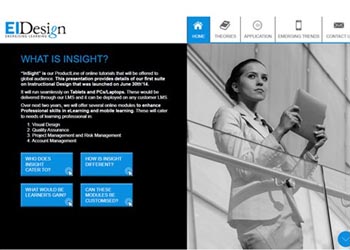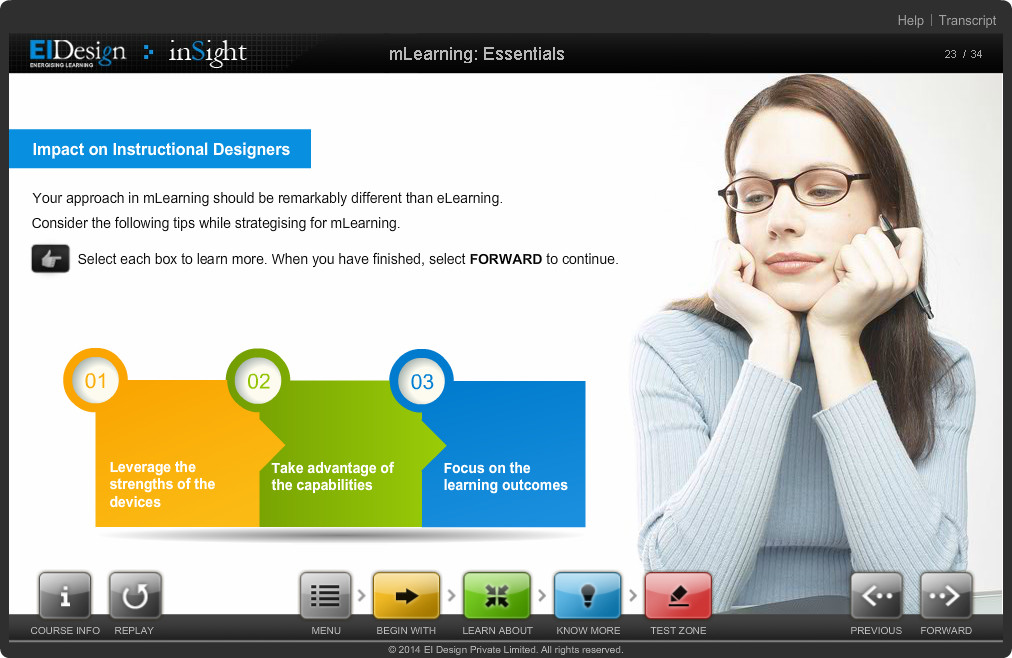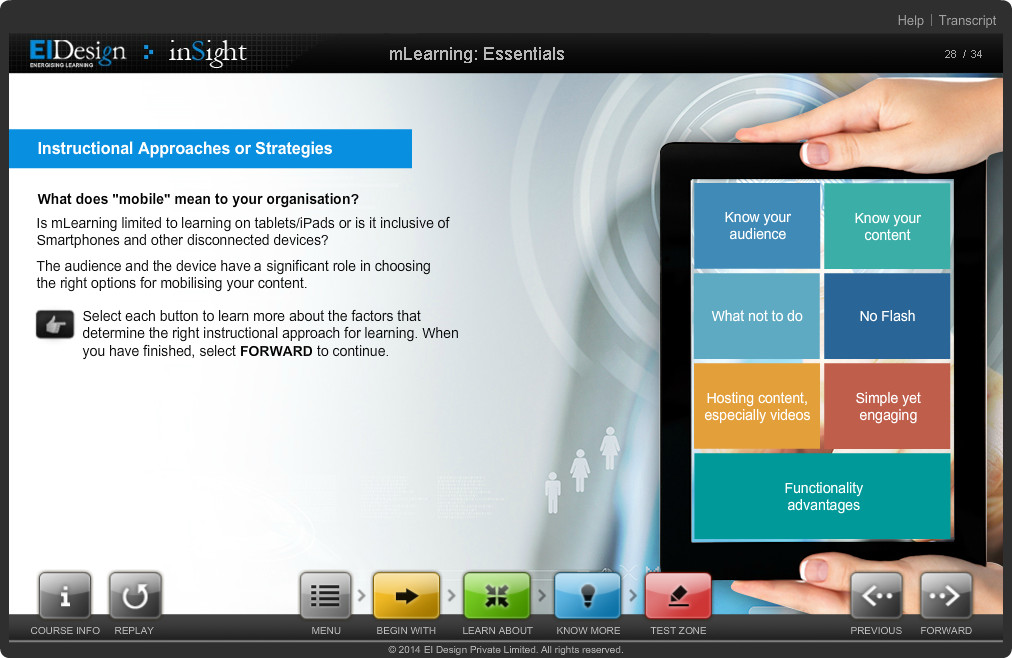
Suite of Online Instructional Design modules to bridge the gap between “Theory” and “Application” – The journey of creating a suite of courses dedicated to best practices in Instructional Design.
New Concepts Series-Featuring our ProductLine InSight for Instructional Designers
Early in my career as the Head, Instructional Design for my company, I had challenges in getting access to training materials for my Instructional Design team that could provide short nuggets of theory that were easy to internalize and easy to apply. Specifically, I needed training material that carried information that my ID team could use quickly apply at work. Un-fortunately, we could not quite get this mandate fulfilled.
Last year, we embarked on the journey to create our own ProductLine series that could offer this value to Instructional Designers across the world. In this blog, I am sharing our journey and the outcomes. (We created a suite of 15 modules and launched it on June 30th’14).
Besides the pointers mentioned above, we added the following:
- With sweeping changes in last two years on account of Mobile learning and need to adapt Instructional Design practice to create effective multi-device builds (running on tablets as well as PCs/laptops), we thought of adding a section on “Emerging Trends” that will address the topical buzz.
- While we felt that the various modules are part of a single suite and would have consistent information and user experience, yet each module should also offer a learning strategy as a learning takeaway. We felt this would resonate well with our target learners and they could go back to our modules to take pointers on how to create effective learning strategy as well.
I am taking a Q&A approach to outline our journey on what we did and finally, how did we fare.
1. What were the focus areas in analysis and strategy phase?
- There should be an integrated suite that can meet the varied expectations of diverse learner profiles.
- It should have a balance of theory and application with a clear set of cues on how to practically apply the theory.
- As the technology is changing, it should provide pointers on how to adapt to the new dynamics.
- More specifically, the entire suite must ready the learner in using the information practically at work.
- The focus of examples must be on real life situations and the assessments and exercises should simulate the kind of work participants would be eventually engaged in.
2. What is InSight?
InSight is our productline of online tutorials (mobile enabled) that was launched to global audience in June’14. The first suite features 15 online modules for Instructional Designers. InSight runs seamlessly on tablets, smartphones, PCs and laptops and will be delivered through our LMS. It can also be deployed on any customer LMS.
3. What does InSight cater to?
We have built these modules with a focus on Instructional Designers (involved in eLearning and mobile learning). However, individuals who are outside of this field will also find many of the modules to be relevant and useful (most notably, the Project Managers and professionals involved in Solution Architecting).
Suite 1 of InSight is designed for a global audience and works for Instructional Designers at various skill levels. Additionally, it will be very useful for:
- Students
InSight can be used as a non-curriculum supplement to universities offering online learning/educational technology courses. We can customize these modules to align them with any university’s course material. - Corporations
We can customize any module for organizations having in-house eLearning development practice and extend it to offer certification courses for employees.
4. How is InSight different?
InSight products bridge the gap between “theory” and “application”. Each module features a distinct learning design. The series of modules are logically placed in 3 categories- Emerging trends, Theory and Application as shown here.
| Emerging Trends | Application | Theories |
|---|---|---|
| mLearning – Essentials (40 Minutes) |
Writing Effective Objectives (40 Minutes) |
Instructional Design Fundamentals (35 Minutes) |
| mLearning – Strategies (40 Minutes) |
Writing Effective Storyboards (30 Minutes) |
Understanding Cognitive Approaches (30 Minutes) |
| Creating Effective Assessments (40 Minutes) |
Overview of Learning Theories (40 Minutes) |
|
| Determining the Right Audio Strategy (30 Minutes) |
Adult Learning Principles (30 Minutes) |
|
| Guide to Editing – Part 1 & 2 (40+30 Minutes) |
Training Needs Analysis (40 Minutes) |
|
| Content Types and Their Visualization Approaches (40 Minutes) |
Key Instructional Design Models (40 Minutes) |
The theory is supplemented by scenarios, examples, and case studies that parallel the learner’s work environment.
Our first suite for Instructional Designers has the following distinctive aspects:
- Each module features interactive checkpoints focused on testing the learner’s level of understanding. There are also end-of-module assessments to help learners validate their learning through challenging questions (simulating real, work-life challenges).
- Learners are equipped with strategies, tips, and best practices that can be readily applied at work.
- Related, supporting information is available as a webliography under “Know-More”.
5. What is the development tool?
We have used Adobe CS6 with Create JS to develop these multi-device modules. The build has an auto-detect function enabling it to load Flash version for desktops/laptops and HTML5 version for tablets.
6. What’s the gain for the learners?
InSight’s series of modules gives Instructional Designers across the world ready to use information to build successful careers. With InSight, learners will quickly and efficiently apply the training material on the job.
7. Have we met the mandate?
We have received very positive and overwhelming response in the first week of the launch. This re-affirms our belief that every Instructional Designer across the globe will find something of value in these modules.
Here is a preview of our module on mLearning Essentials. I am sharing our approach and couple of screenshots.
1. Learning Mandate
Explore an emerging focus area “mobile-based learning” provide basic information regarding the medium and how it impacts Instructional Designers
2. Instructional Strategy
mLearning, being a relatively new medium, poses several questions for Instructional Designers and other professionals in the learning space about its possibilities, benefits, and challenges.
We have used these questions as a platform to create this module.
The questions:
- Set the context for the learning
- Serve as a lead-in to the key aspects that will be covered in a topic
- Mirror specific concerns or challenges that learners are likely to encounter while designing an mLearning module
- Help to define learning outcomes that will provide practical value and solutions to learners which can be applied in the actual work place
3. Our Solution
The Q&A approach helps in multiple ways:
- Establishes the cognitive flow and the learning path
- Keeps the learning focused and intuitive
- Engages the learners by mirroring their thoughts, concerns, doubts and provides solutions to handle these aspects
- Breaks down information into logical and precise chunks, making it easier for practical application in the workplace
4. Outcomes
The primary goal of the module on mLearning is to highlight how the transition from eLearning to the mobile medium is going to impact Instructional Designers.
Using specific questions and concerns about this uncharted territory as a thread, the module provides practical solutions, design considerations and best practices that will act as a reference point for the learners and help them design an actual mLearning module.
I look forward to your views, suggestions and any other feedback on this.





